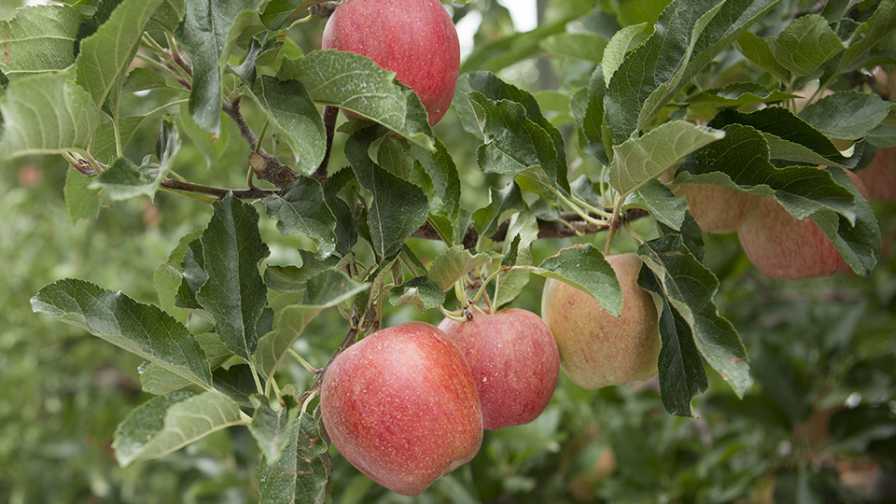How PGRs are Making Pome Fruit Harvest More Manageable

Near-harvest PGRs could be an important asset if COVID-19 labor shortages arise, AgroFresh’s Keith Culver says.
Photo courtesy of AgroFresh
Tree fruit growers, because of various social distancing mandates created to limit the spread of COVID-19, are facing exacerbated labor shortage pressure.
Therefore, according to Keith Culver, Commercial Director of North America at AgroFresh, it has never been more critical that apple and pear growers be provided with technical reliability to optimize efficiencies by way of labor management.
Enter plant growth regulators (PGRs). PGRs are used on pome trees to modify plant growth, such as increasing branching, suppressing shoot growth, increasing return bloom, removing excess fruit, or altering fruit maturity.
One example of a PGR is AgroFresh’s near-harvest product (Harvista), which Culver says has a unique mode of application that inhibits the production of ethylene and can be applied up to three days before the anticipated harvest. Harvista is used pre-harvest to maintain quality while extending the harvest window for optimal flexibility.
“The latest innovation we’re seeing with PGRs in the tree fruit industry is the use of pre- and near-harvest PGRs to deliver high-quality fruit and create harvest management flexibility,” Culver says. “Growers and packers have used PGRs for many years to manage fruit in storage, but there are now in-the-field modes of application that benefit tree fruit growers with more flexibility with their harvest window.”
In the midst of the coronavirus pandemic and possible labor shortages, “near-harvest PGRs can help tree fruit growers gain more control over their harvest window, an important asset during these challenging and uncertain times,” Culver says.
Wide-Ranging Attributes
PGRs help tree fruit growers optimize all inputs in fruit production, Culver says, such as pest management, water usage, and high storage potential. Optimizing these inputs results in enhanced fruit quality.
Another relevant issue across the industry is food waste, which occurs on a daily basis, Culver says. AgroFresh, he adds, continuously innovates to provide freshness solutions that help reduce food waste by extending the shelf-life of fruits and vegetables.
The company’s post-harvest technology solution (SmartFresh) delays the ripening process to protect just-picked freshness and quality for consumers, Culver says. The technology supports postharvest ripening and conditioning protocols in various supply chain stages, while extending the storage window to improve inventory flexibility. The technology is effective with many crops, including pome fruit, avocado, banana, melon, tomato, broccoli, mango, peach, nectarine, plum, persimmon, kiwifruit, lime, and watermelon.
AgroFresh’s transplant technology (LandSpring) eases early environmental stresses, such as heat, cold, salinity, and UV rays, that can take their toll on plant seedlings. The technology helps to generate higher yields and better seedling survival rates, Culver says.
Plenty to Choose From
Valent USA currently offers nine PGRs for pome fruit with two more in the pipeline, according to Field Market Development Specialist Allison Walston. Those products cover fruit set (ReTain), fruit thinning (Amid-Thin, Fruitone, MaxCel, PoMaxa, and ProTone), russet control (ProVide), and stop-drop management (K-Salt Fruit Fix, Promalin, and ReTain).
“Apple and pear growers routinely use PGRs,” Walston says. “From fruit set to thinning to harvest management, the tree fruit growing areas have multiple PGRs to choose from, and it all depends on how they would like to manage their fruit.”
One aspect of PGRs that tree fruit growers should realize, Walston says, is that the dilution rate of the PGR in water is critical.
“Normally we discuss this ratio in parts per million instead of the measured rate per acre. If the concentration is too high, abnormal things can happen. If the concentration is too low, we won’t see much happening,” Walston says.
Another important factor, she notes, is evaluating how stressed the tree is, taking into account factors such as hot days, frost events, and cloud cover.
“PGRs typically react and have more impact when the tree is under these types of stress situations,” Walston says. “Between concentration of material in water to the weather, it is important to not underestimate the power of the PGR.”











